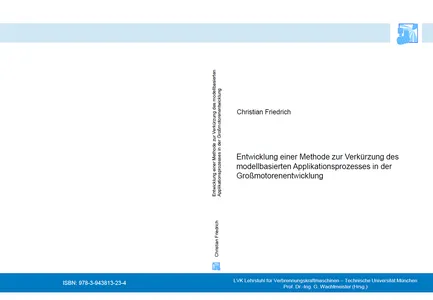Dissertation, 2018
from Dr.-Ing. Florian Schwarzmüller
Abstract
Diesel engines play a significant role in society. In addition to the use for commercial vehicles and stationary engines, its significance for individual traffic increased in recent decades. A continuous development of the engines contributes this trend. One significant point of this continuous development is the injection as an essential element which allows optimizing the combustion process and reducing the emissions of diesel engines. In addition, high requirements through increasing specific load while, in parallel, lowering the allowed amount of carbon dioxide and pollutant emissions, comes along with an extended complexity of the development process. Amongst other things, one have to look detailed at dynamic effects during injection, because their influence to spray and mixture generation is no longer negligible in the early design phase. So the use of virtual instruments gets more important to control the complexity. Predictive tools offer huge advantages, if they are used in the early period of development process.
The development of such a tool depends on a good understanding of the system. In case of injection, spray and mixture formation, this includes knowledge of the influence on the nozzle flow, as well as the interactions between fuel and the surrounding gas phase. A holistic approach is therefore essential to the injection modelling. This thesis includes the study of the injection process with experiments and simulations. Aspects of both support and deepen the understanding of the injection process. On the one hand experiments generate a comprehensive data base, on the other hand they support the production of boundary conditions, and lead to the validation data needed for the simulations.
The tests include measurements of injection rate, as well as the needle lift in order to describe the hydraulic characteristic of the injector. This information is used to validate an injector model for the simulations which has been built up in a 1D work frame. Further tests contain optical measurements of the spray to determine the penetration behaviour and the spray angels next and faraway to the nozzle. Different kinds of simulation reconstruct the measured quantities and processes. A prerequisite for such simulation is a one dimensional hydraulic model of the injector which sets up the basis for the boundary conditions of the three dimensional CFD simulations of nozzle flow and the spray process. Findings on the flow inside the nozzle resulted from these simulations. Together with the experiments a phenomenological approach is derived to describe the flow from sack hole to nozzle hole, which is not available in other simulation tools so far.
In an early design phase this phenomenological approach enables the calculation of the characteristic spray sizes. It is taking into account dynamic operations using a simple calculation tool in combination with customized and advanced models to calculate the nozzle flow and the spray formation. As great advantage the model requires as user input parameter only in this design phase known geometric description of the nozzle, as well as the time resolved pressure befor needle seat, needle lift and pressure and density of the gas atmosphere.
Extent: 143 pages
ISBN: 978-3-943813-26-5
Price: 33 € ( 2 € for dispatch)
Ordering: verlag(at)lvk.mw.tum.de
